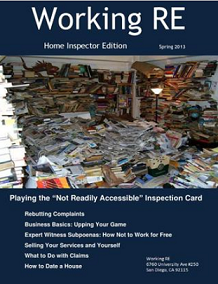 |
>> See Past News Editions >> Follow our NEW Home Inspector RSS Feed >> Click to Print >> Note: If you live in “high-priced” states like AZ, CA, IL, NJ, PA, FL, TX or WA, OREP does not limit coverage or raise your rates. The same rates apply in all states where program is offered. Same day coverage. |
Clothes Dryer Vents: The Proper and the Improper
By Matthew Steger, ACI
I continually run into confusion from property owners and Realtors regarding what the proper venting material should be for clothes dryers.
Statistics from the Consumer Product Safety Commission (CPSC) show that over 24,000 house fires and nearly $100 million in property damage annually are related to faulty clothes dryer vent installations. House fires related to clothes dryer vents are much more common than most people believe but luckily are relatively easy to prevent. The photo below illustrates how dirty many dryer ducts are and most people would have no idea until they either (1) have a fire, or (2) decide to finally clean out their dryer vent.
(story continues below)
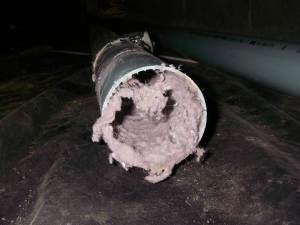
(story continues)
During a normal drying cycle, up to a gallon of water may be drawn out of the clothes in the form of water vapor. The purpose of the dryer vent system is to transport this water vapor, and the lint that accompanies it, to a safe location outside the home. The most commonly seen improper type of dryer vent is flexible vinyl tubing. Vinyl is a type of plastic and it can easily melt and lead to a house fire. This material, most often white and ribbed, tends to allow for lint to readily accumulate. Lint is very flammable and all it takes is a small spark to ignite it leading to a house fire.
The more lint that fills a clothes dryer vent, the more energy the clothes dryer consumes to try to dry the clothes as air won’t freely flow through the clogged vent material. This, in turn, causes the drying cycle to be much longer than normal and raises utility bills. The photo below shows an installation of vinyl tubing. (story continues below)
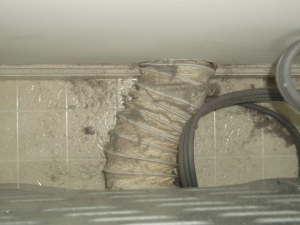
(story continues)
Another improper dryer vent material that I routinely see installed is mylar foil tubing. It is a flexible ribbed shiny tubing that many home owners and contractors have installed and they wrongly assume that it is metal because it is shiny. Mylar foil tubing is not approved for use as a clothes dryer vent material and should not be used for this application. The photo below shows an installation of mylar foil tubing which actually runs behind a fixed wall covering and was the only dryer vent material installed in this particular home.
A few manufacturers of mylar foil tubing have been able to obtain a UL listing; these products specifically should be used as the transition duct ONLY between the dryer and the actual rigid metal dryer vent (not the full dryer vent!). It the mylar transition duct is UL approved, it will have a UL sticker on it. If it has no sticker, then it should be assumed that it is not UL listed and should be replaced with a proper dryer vent material. The transition duct should be as short as possible to connect the dryer to the metal dryer vent and it should be no longer than 8 feet. The transition duct must not run within a wall, floor, or ceiling covering since it will not be able to be visually inspected and can’t easily be cleaned. (story continues below)
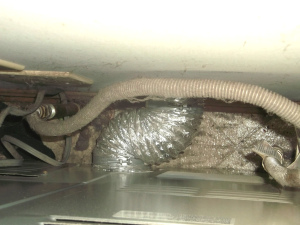
(story continues)
I also occasionally find mylar tubing venting a clothes dryer into the basement with a plastic container (see photo below). First, the tubing is incorrect. Second, venting the clothes dryer into the basement takes the moisture out of the clothes that the dryer is drying and discharges that back into the home. This creates an environment that is a fire-hazard (lint) and a mold-hazard (moisture). (story continues below)
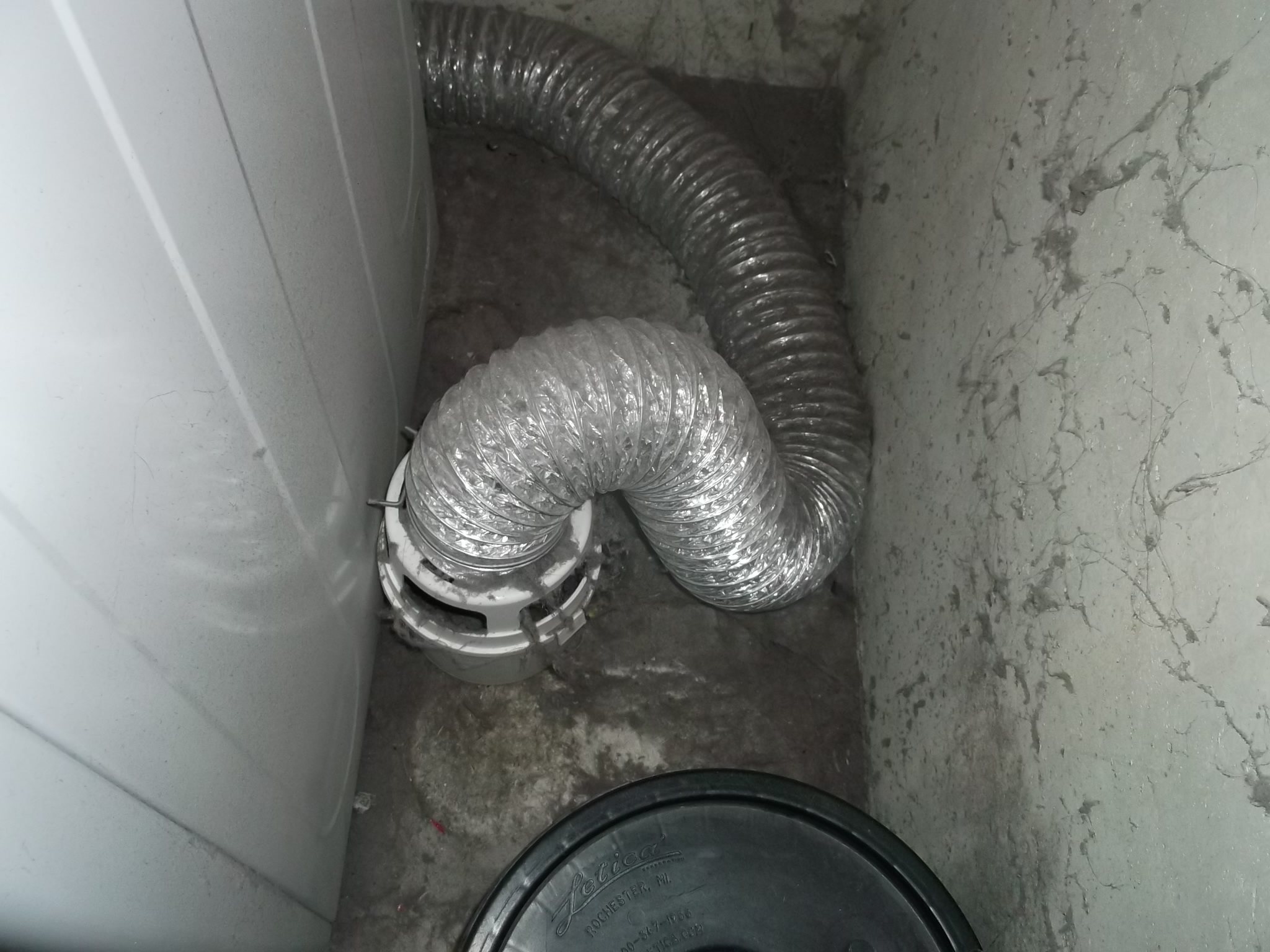
(story continues)
Something that I’ve been running across more often lately in homes built within the past 15 years is some builders installing 4 inch PVC drain pipe as the clothes dryer duct. At one inspection from this past spring, I even saw a black corrugated plastic drain pipe (normally used for draining exterior water from downspouts) being used as the home’s dryer vent. While PVC is meant for plumbing and venting applications, PVC is not approved for venting a clothes dryer and should not be used for this application. PVC pipe can allow a static charge to build up; this static charge can ignite the dryer lint leading to a fire. The photo below from a recent home inspection shows vinyl tubing (left side) connected to PVC pipe (right side) with cloth duct tape.
(story continues below)
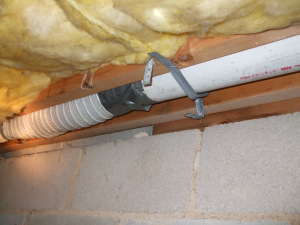
(story continues)
The International Residential Code (IRC) section M1501 requires that clothes dryer vents be constructed of at least 0.016″ thick rigid metal, have smooth interior surfaces, and shall not have sheet metal screws extending into the duct. The clothes dryer vent should meet the UL 2158A standard. Sheet metal screws penetrating into the material can allow lint to get caught on the screws and possibly clog the vent over time. Keep in mind, a home inspection is not a code compliance inspection and that the Authority Having Jurisdiction (AHJ) is the responsible party for determining/verifying code compliance. The home inspector is using these standards, however, as a reference to help protect his or her client from possible future hazards, such as a house fire. The photo below shows the proper rigid metal duct material. Notice how this rigid metal duct looks nothing like the mylar foil material. This material can’t easily be bent. (story continues below)
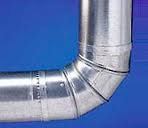
(story continues)
Dryer ventilation systems should only terminate to the home’s exterior and have a proper dampered exterior cover to help prevent water, birds, and insects from entering the duct. The exterior cover should not have a screen since it will cause lint build up and block the vent over time. Venting a clothes dryer into a garage, basement, attic, or anywhere else inside the home can lead to excessively high humidity levels, mold, and an increased fire risk. Also, a clothes dryer ventilation line should terminate to an area of the home’s exterior where it cannot be blocked by vegetation, snow, or dirt, and be at least 3 feet from doors and windows. The vent also should not terminate near an air conditioning compressor as the dryer lint can accumulate on the A/C compressor which can prevent proper operation of the A/C system.
Flexible rigid metal ducting (this specific material is only slightly bendable) is recommended where the rigid metal duct material connects to the clothes dryer. The photo below shows flexible rigid metal ducting. Notice how different this rigid metal material below looks compared to the mylar foil ducting shown in the 3rd photo from the top of this article. If the clothes dryer and exterior vent are in close proximity, a single piece of flexible rigid metal duct (as seen below) can often be safely used as the sole duct, assuming it does not pass behind a wall, floor, or ceiling covering. (story continues below)
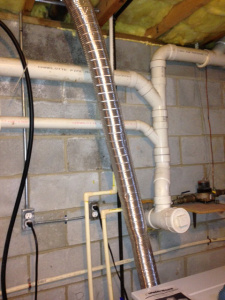
(story continues)
I also sometimes find dryer vents that far exceed 40 feet. I recommend that the vent system be modified to terminate to an alternate exterior location closer to the laundry appliances to allow a shorter run. Most standards call for clothes dryer vents to be no more than 25 feet in length, have few bends, and no kinks. Gas dryers, though, are often permitted to have ducts no longer than 35 feet in length. The more bends in the line that exist, the shorter the overall length should be. For every 90 degree bend, the vent should be shortened by 5 feet; for every 45 degree bend, the vent should be shortened by 2.5 feet. An exception exists if the clothes dryer’s manufacturer specifically permits a longer vent but, in most cases, the inspector does not have this documentation from the clothes dryer’s manufacturer.
With every home inspection, I always recommend that the clothes dryer vent system be thoroughly cleaned at least twice per year as preventative maintenance. A home owner can take apart and clean the dryer vent’s interior himself. This is made easier with a vacuum cleaner with a long hose attachment. Some HVAC professionals and chimney sweeps also offer dryer vent cleaning as a service.
During a home inspection, the inspector should try to determine the type of clothes dryer vent material(s) installed. In some homes, only parts of the clothes dryer vent system may be visible. Often, socks or other clothing have fallen behind the laundry appliances against the wall and these items can block the view of the dryer vent where it passes into a wall or floor. Installed insulation, ceilings, or walls as well as other stored items in a basement can also block visual access to the dryer vent material. Of course, home inspectors do not move insulation, disassemble walls/ceilings, or move appliances to perform the inspection. Some chimney sweeps, and disaster cleanup companies offer professional dryer vent cleaning. Special tools are needed to properly clean these vents, especially the longer vents. Short vents can often be cleaned by the homeowner, however.
House fires related to improper or blocked dryer vents are easily prevented and a little bit of preventive maintenance can help save lives. When was the last time you inspected and cleaned your clothes dryer vent? Your family’s safety, and those of your clients, may depend on it.
About the Author
Matthew Steger, owner/inspector of WIN Home Inspection, is a Certified Level 1 Infrared Thermographer and an ASHI Certified Inspector (ACI). He can be reached at: 717-361-9467 or msteger@wini.com. WIN Home Inspection provides a wide array of home inspection services in the Lancaster, PA area. ACI WIN Home Inspection – “WE SEE MORE. CLEARLY.” ASHI Certified Inspector Certified Level 1 Infrared Thermographer Phone: 717.361.9467 Fax: 831.306.9467 Web: WINHomeInspectionElizabethtown.com
>Click to Print
>Subscribe to Working RE Newsletters
Send your story submission/idea to the Editor: dbrauner@orep.org


by jay jones
why have a question and answer section if no one is answering?
-by Matthew Steger
Sorry.. I wrote this article years ago and never saw that people left comments a few minutes ago. Working RE magazine doesn’t notify me if/when people leave comments to my article in their magazine.
-by k. thompson
What is the best way to attach a dryer vent cover if your outside wall is stuco
-by Matthew Steger
The same was as if your home is brick, vinyl, etc. The exterior vent should be embedded in a bead of sealant and then inserted into the wall from the exterior. This allows replacement in the future should the vent ever get damaged, etc.
-by Isabel M Valdes
There are 3 pipes venting out from my flat roof through one opening into one goose neck. One is a dryer vent, other a bathroom vent and a kitchen vent. Is that correct that all three pipes go out through one opening at the roof?
-by Matthew Steger
All venting systems (bathrooms, kitchens, clothes dryers, etc.) need to terminate independently to the exterior and may not be combined.
-by Michael
Hi Matthew- our new dryer has a 4” diameter vent hose but our house termination vent hole is 3”. Can we use a 4” to 3” adapter at the exit point of house without too much issue? We pan on cleaning out vent every 6 months. Ps. There is an S curve since the dryer vent is at the floor but the house vent exit is within and 3 feet higher on the wall.
-by Matthew Steger
The vent should remain as 4″ duct during is entire run from the dryer connection to the exterior. It should not get smaller as that diminishes the amount of air flow through the system.
-by Luke
Man, you hit the nail on the head. It’s not every day you see mylar tubing coming out of a dryer, but when you do, its not good. Good explanation of the UL listing too.
-by Cynthia Phillips
Please address the obvious issues resulting from a dryer vented to our garage my spouse believes this is acceptable practice a
-by Matthew Steger
Dryer vents discharge moisture and lint. Either venting into a garage, basement, attic, etc. increases the chance of mold or a fire. Also, venting into a garage compromises the required fire-separation for garages and may allow carbon monoxide into the home. (Sorry, I wrote this article but I don’t get notified if people leave comments on this website)
-by Dave
Even though it would be over kill, can I use ducting meant for water heater but use it solely for the dryer.
-by Matthew Steger
Dryer vent ducting must be 4″ rigid metal duct meeting the UL 2158A standard. Vents for water heaters don’t meet that standard.
-by Linda Viebrock
I have a shared dryer vent in my condo that vents out the top of and attached utility room that is about 10 Feet tall , when my neighbor runs her dryer I get the scent from her laundry detergent in my dryer and also get moisture in my dryer from when neighbor runs her dryer , I am very allergic to the scented laundry detergent and am getting swollen eyelids and infection in my eyes from this, we just had the vents cleaned and still the same problem, .ate shared vents in violation of code for condos please help what can I do, thank you
-by Mark Dadian
Shared vents are strictly forbidden. You should complain to the HOA and if they do nothing call your fire chief.
-by Matthew Steger
Building codes strictly forbid combining bathroom fans, dryer vents, etc. All vents must be run independently to the home’s exterior.
-by Aaron Lee
It’s scary to know the number one cause of home fires are dryer vents. Not to mention, it’s irritating when clothes don’t dry on the first cycle.
-by Matthew Steger
If your clothes dryer takes more than 1 cycle to dry your clothes, that tells me either (1.) your washing machine is leaving too much water in your clothes, (2.) your clothes dryer heating element (if electric) or burner (if gas/LP) isn’t working properly, or (3.) your dryer vent is not clean.
-by lois young
Back in the good old days when a dryer was expected to last between 15 and 20 years. The rule was that a vent should go directly out of the house. The maximum length was 16 feet with no elbows or kinks. One elbow was allowed but must be kept clean. If your vent goes through the roof do not buy the house. If it vents into a crawl space, move anything you really want to a storage facility, you have an extreme fire threat under your entire house. If you have any doubt, clean your lint screen and keep the lint from a couple loads, take the lint outside to a safe place and apply a lighter to just a small bit of the lint. If you watch it the fire will migrate and engulf all of the lint. That is what is waiting a spark under your house. The same happens inside a dryer with a kinked or to long of a vent. Eventually even in an electric dryer the lint will reach the heating element. Goodbye dryer and possibly house.
-by Matthew Steger
This is pretty much why I wrote the article years ago.. most homeowners never think about the potential fire hazard of an improperly constructed or maintained dryer vent. Plus, they also don’t understand the potential for mold in their home related to this.
-by Cathie
I purchased a very old mobile home on a lot where it has been for many years. The washer and dryer are in the bathroom close to the rear of the house. The dryer vents out under the house. And I’m guessing has done so for all these years. How do you vent out a dryer to the outside? The closest would be approximately 15 feet and would require quite a bend. Plus, same side is the central air unit …as I read, not to vent near that. I’ve been in the home going on 3 yrs and have not cleaned the vent. Also, there is quite the odor in the home that I’m not sure where it is coming from.
-by Matthew Steger
The dryer vent should not terminate under a manufactured home as that keeps lint and moisture in the crawl space. The vent needs to run directly outside through the exterior wall and discharge to the home’s exterior.
-by KAREN GREEN
We bought a new dryer and hose and it runs up and a couple turns. Its in the basement. Since day 1 we have clothing lint all over our house. On sinks, kitchen, refrigerator, its small particules, but its non stop. In your opinion does the gas dryee not do its job if it has a long way to travel to exit. Its really on everything in our house. Even walls. It was professtionaly connected, and all parts are new. Makes no sense?!?
-by jim
It sound like the air isn’t being ducted to the outside of the house, or the duct you have is leaking somewhere.
-by Mark Dadian
Get a good quality tape designed for metal ducts (NOT duct tape) and seal the joints.
-by Matthew Steger
If this is happening, there is a serious issue with your dryer vent. As noted in the article, it should be as short as possible with a minimum of bends. Gas dryers should function properly if a proper dryer vent is installed and regularly cleaned. If lint is leaking out of the vent, there is likely a break or unsealed seam somewhere. Have a qualified HVAC contractor check out the duct and repair as necessary, If the vent leaks into the home, it is leaking moisture, too. This can present a fire or mold hazard.
-by lynn
is it okay to have a dryer hooked up using no joints? i have the semi rigid vent pipe attached directly to the dryer and vent outlet. its only about two or three feet long and works okay but all the photos i have seen use the joints.
-by Matthew Steger
Dryer vents don’t need to be multiple pieces.. a short single piece that runs directly from dryer to the exterior is best.
-by Leviticus Bennett
It’s good to know that you recommend the dryer vent being thoroughly cleaned at least twice per year. I’ve never cleaned my dryer vent and am not quite sure how to. Usually if I try to do things myself, I break them, so I’ll call an HVAC contractor to clean mine out.
-by Matthew Steger
Most HVAC companies offer duct cleaning. Some chimney sweeps also offer this type of dryer vent cleaning and there are also companies that specialize in dryer vent cleaning.
-by Susan Broussard
Is it code to exhaust a dryer vent to blow in the attic?
-Susan Broussard
subroussard@gmail.com
by Mike
No! By code it must vent to the outside. Venting into an attic or crawl space will encourage mold growth in those areas.
-by roger
is it better to use 2 90 degree angles, one out of the dryer and one at the top going out or 1 90 degree out of the back of the dryer and 2 45 degree angles the rest of the way
-by Matthew Steger
It likely doesn’t matter either way as long as the overall runs are short and the vent is cleaned regularly.
-by Tee
What if you have an electric dryer in a tiny closed room, with a heat vent (gas furn. And water heater) in the same room as the dryer would it cause a gas backflow through the heat vent from the dryer not having combustion air? When the heat comes on w the dryer or stove on my family acts crazy, the winter is worse, i wake w joint pain and coughing blood…i cant get anyone to see whats happening. At the exact time these appliances are being used my.kids fall asleep we all get headaches and everyone argues…when i tell them its co …they throw me out of the house…hard to see whats happening when your in it…also what happens when a dryer electric is exhausting outside directly above the combustion intake of a high eff. Furnace? Thank you for any help you can give!
-by jim
You are correct. The answer is to get a heating/air conditioning contractor in there pronto to provide a source of make up air.
-Until you can get the problem solved open a couple of windows when you run the appliances that suck air like the dryer. Especially in winter.
Lots of people die every year from carbon monoxide poisoning.
by Matthew Steger
Sounds like a potential carbon monoxide (CO) poisoning issue may be occurring. I would consult a qualified HVAC contractor immediately and not using any fossil fuel appliance until that contractor has checked things out thoroughly.
-by Al Dingfelder
Matthew, I would like to put a copy of your article In our local CT home inspectors (CAHI) newsletter. I am having trouble getting our members to write articles and want to use your article as a good example of what they should be trying to do.
-by Matthew Steger
Hi Al: I have updated the article over the years (this one was written almost 10 years ago). I can provide an updated version if you contact me.
-by Dave
Nice article. Please note – both sections of the IRC now show 35′ as the maximum length. One aspect you did not cover is the use of listed dryer vent booster fans. There are a few that do a good job but many do not (they are converted Radon venting fans). When used these fans must be accessible for maintenance and must comply with a few other rules.
-by Matthew Steger
Good point. I didn’t discuss booster fans. Some manufacturers do not approve their units to be used with booster fans. 25′ is typically rule of thumb for length for electric dryers although gas dryers are typically permitted for a max of 35′. Standards have changed over time.. I write this article around 2014. I have an updated version at my website.
-by Matt Steger
The updated (current version) of my article mentions the new length allowances as well as mentions booster fans. The version posted above is 10 years old and was based upon standards at that time. Click on my name above to access my website where you can see the current article version.
-by T. M. Pino
Good article. Some builders have the dryer located in the middle of the house and I have seen three or more elbows during construction and have requested that if they are going to locate the clothes dryer in the middle where the length is longer than 35 feet including the 15 feet for the three elbows, they must increase the diameter of the duct as is required by the dryer manufacturer or under the International Residential Codes for One and Two Family Dwellings, under #M1502.
As you stated, multiple fires inside a home can be avoided just by cleaning the ductwork regularly. This should be placed on a “Check List of Maintenance Items” that should be done every 6 months.
-by Matthew Steger
From my experience, when builders place the laundry area near the home’s center, they run the dryer vent straight outwards below the floor structure to the exterior which in most cases, allows the vent length to still be as short as possible.
-by jeff adams
Nice article on the cloths dryer, so many people completely overlook this aspect in their home maintenance. So many fires could be prevented with just a little care.
-by Matthew Steger
Thank you. I wrote this article nearly 10 years ago.. I have an updated version at my website now: https://thehomeinspectorsnotebook.com
-by Bruce McCrary
Thanks for taking time to write about an issue that often if played down because of the lack of access. It is; however, very important and the article helps to put it on the front burner. Good article, continue to share.
-by Anthony Westbrook
Great article. This is something we all see way to much. Thank you for sharing.
-by William Zoller, CRI
Great article! Very clear and complete. After 10 years, I’ve seen a multitude of dryer venting configurations, and more than a few not so healthy. How about a ‘debris under refrigerator’ for your next writing. I’ve known of a couple of house fires with that one! Thanks again.
-by Bob Mulloy
Excellent article, my compliments.
-Bob Mulloy, ASHI ACI #32
ASHI-NE Chapter Education Chairman